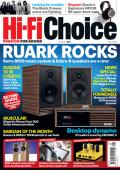MAD 1920


My Audio Design is one of hi-fi ’s newer and more surprising operations. It’s headed by Timothy Jung, a British entrepreneur who combines youth, enthusiasm and imagination with a passion for making loudspeakers here in Britain. And some of its designs are indeed MAD – check out the extraordinary Royal Salute!
The inspiration
That’s certainly not the case with the 1920. Despite its curious name, this loudspeaker is conceived as a tribute to the classic BBC LS3/5A sub-miniature, which continues to enjoy cult popularity and a succession of lookalike models from several manufacturers.
In truth, the 1920 is much more of a homage to, than a replica of, the LS3/5A. From the front it does indeed look very similar – it’s roughly the same width and a smidgeon shorter in height. However, the differences are equally signifi cant, as the 1920 is signifi cantly deeper (by about 44 per cent) and has a generous rear port (the 3/5A is a sealed-box design).
Other differences are even more substantial. For example, the 1920 claims a generous sensitivity of 90dB, whereas the 3/5A is way down at 82-83dB (partly explained by very different impedances).
The basics
Forget the LS3/5A; it’s better to consider the 1920 as a simple, yet very carefully refined reflex loaded two-way. It uses high quality ingredients, such as MAD’s ESA Diamond Silver capacitor and silver solder in the 2kHz crossover. The Wavecor drivers include a 145mm bass/mid unit with a 100mm doped flared paper cone, while the tweeter has a 22mm soft-fabric dome. The enclosure comes fi nished in highquality walnut or cherry real-wood veneer and is constructed using MAD’s DRC multi-layer approach to damping.
The sound character
Although it’s not strictly neutral, the 1920’s seductive sound quality has considerable charm. Arguably, its best feature is its bass delivery. Although its small size (and 60Hz port tuning) inevitably limits absolute extension, the overall bass alignment is particularly clever and practical, successfully avoiding the problem of midbass excess that plagues so many compact standmounts. Especially under our listening conditions, a result which hampered all of those in last month’s Blind Listening Group Test (HFC 353) to a greater or lesser extent.
The 1920’s essentially dry bottom end responds well to a certain amount of close-to-wall bass reinforcement. However, place it too close and the increase in midband coloration can become a little too obvious – a space of around 35cm seemed to give the best compromise.
Further up the band a rather too well-projected upper midrange brings explicit detail to the fore. Cabinet coloration is low, but some boxiness constrains transparency, so voice intelligibility is good, but there’s also a tendency to ‘shout’ when the volume is high. Furthermore, this mild forwardness is somewhat exaggerated by a signifi cantly restrained top end. It’s very smooth and well maintained here, but at a distinctly understated relative level.
The 1920 has a claimed sensitivity of 90dB and this corresponds quite closely with our findings based on far-field in-room measurement. One contributing factor is an impedance which is essentially four ohms over the two prime midband octaves 200-800Hz.
The port here is tuned to a relatively high 60Hz, while the relative bass output is lean enough to suggest that some wall reinforcement might be helpful. Output is very well ordered across the broad midband and lower treble (from 120Hz up to 2kHz), but then drops away steadily, but smoothly through the treble proper.
Good dynamic expression
The 1920’s impressive coherence actually has some of the flavour of a single full-range driver speaker. Some might find its overall character a shade boxy and lacking in sparkle, but others will welcome the fact that the tweeter doesn’t draw attention to itself and enjoy this speaker’s superior bass agility, good dynamic expression and fine midband communication. It might look like an LS3/5A, but it certainly doesn’t sound like one.
LIKE: Superior bass alignment and a lively, coherent overall sound
DISLIKE: Lacks sparkle, because treble output is a little too restrained
WE SAY: Classic styling cues; fine bass alignment and a lively, if somewhat forward character
DETAILS
PRODUCT: MAD 1920
PRICE: £1,350
ORIGIN: UK
TYPE: Two-way standmount
WEIGHT: 5.5kg
DIMENSIONS (WxHxD):190 x 280 x 230mm
FEATURES:
• Classic styling with picture-framed inset grille
• Inspired by the BBC’s LS3/5A design
• 145mm driver covers the bass and midband
• Rear port
• MAD Diamond silver capacitor
DISTRIBUTOR: My Audio Design
TELEPHONE: 020 8123 9789
WEBSITE: madengland.com
 |
Inside this month's issue:
Ruark R610 music system and Sabre-R standmount speakers, PMC twenty.23i Active, floorstanders, English Acoustics Downton preamplifier, Bluesound NODE ICON preamp/streamer, Ortofon Concorde Music Blue MM cartridge and much, much more
|













































